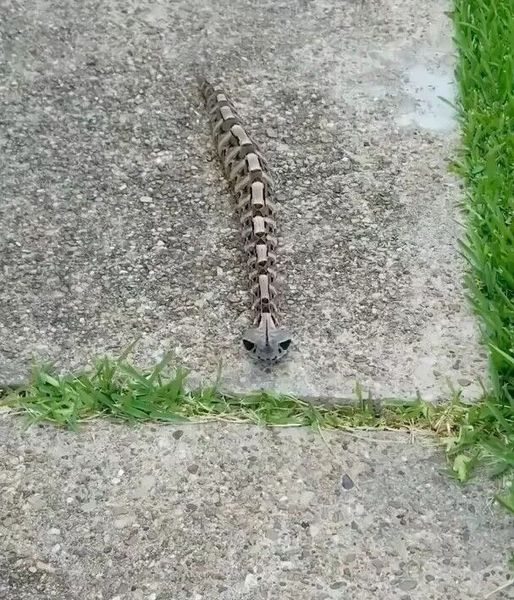Deep within the lush rainforests of Africa hides one of nature’s most mesmerizing yet dangerous creatures: the Gaboon viper. Known for its exceptional camouflage, this snake remains hidden in plain sight until it is ready to strike. Its ability to blend seamlessly into its surroundings, coupled with its incredible venom potency, make the Gaboon viper a lethal predator and a master of silent hunting.
Unmatched Camouflage and Stealth
The Gaboon viper’s skin patterns are among the most intricate and effective in the animal kingdom. Its body is adorned with brown, yellow, and purple hues, mimicking the dead leaves scattered on the forest floor. This allows the viper to remain virtually invisible, lying motionless for extended periods until its prey comes dangerously close. “The excellent camouflage makes the snake blend perfectly into the leaf litter on the forest floor – it’s almost impossible to discover it before it strikes,” a wildlife expert notes.
This patience is key to the Gaboon viper’s success as a predator. The snake can wait for hours, even days, before launching a rapid and devastating attack. Its prey often includes fully grown rabbits, monkeys, and small antelopes. With fangs measuring up to two inches, the viper’s bite delivers a massive dose of venom, causing instant paralysis or death.

Venom: A Deadly Cocktail
The Gaboon viper’s venom is a complex blend of enzymes and toxins designed to immobilize prey and begin the process of digestion. Upon biting, the snake can inject an enormous quantity of venom directly into its victim’s bloodstream. This venom acts swiftly, breaking down tissues and causing excruciating pain, swelling, and in some cases, rapid death if left untreated.
Reports suggest that the viper’s venom can lead to “severe tissue damage,” and cases where anti-venom was not administered promptly have had fatal outcomes. Although bites on humans are rare due to the viper’s preference for remote areas, accidental encounters, often involving individuals stepping on the camouflaged snake, have led to life-threatening injuries.

The Largest Viper in the World
In addition to its venomous bite, the Gaboon viper holds the title of the largest viper in the world. Some specimens grow up to six feet in length and can weigh over 20 pounds. Despite its size, the snake’s agility and speed when attacking are remarkable. Its enormous head and triangular shape only add to its fearsome appearance. This size, combined with its lethality, makes the Gaboon viper a creature of both awe and terror.
Interestingly, its calm and non-aggressive nature contrasts with its deadly capabilities. The Gaboon viper is not known to attack unless provoked, which is why incidents involving humans are scarce. However, in rare situations where a person accidentally steps on the snake, the consequences can be severe.

Pet Ownership Gone Wrong
Despite the viper’s danger, some enthusiasts keep Gaboon vipers as exotic pets, often with disastrous results. In 2022, a man in Virginia was bitten by his pet Gaboon viper, requiring immediate medical intervention. The emergency was further complicated when local hospitals ran out of anti-venom. “The VCU Medical Center had exhausted its supply of anti-venom, which had been provided by the Smithsonian National Zoo,” a report mentioned. Fortunately, additional anti-venom was supplied by a nearby aquarium, saving the man’s life.
This case was not an isolated incident. Just months before, another Gaboon viper bite occurred in North Carolina, resulting in severe injuries. The man needed 44 vials of anti-venom, and despite treatment, he tragically lost several fingers. These incidents highlight the risks of keeping such a dangerous animal in captivity, particularly for those without proper expertise.
Conservation and Role in the Ecosystem
Though often feared, the Gaboon viper plays a crucial role in maintaining the balance of its ecosystem. As an apex predator, it helps regulate populations of small mammals and other prey species, preventing overpopulation and maintaining biodiversity. Its presence in African rainforests and savannas is vital for the health of these ecosystems.
Unfortunately, habitat destruction and illegal wildlife trade threaten the Gaboon viper’s survival. Logging, agriculture, and human encroachment into its natural habitat have reduced the snake’s range. Moreover, the demand for exotic pets has led to poaching, further endangering the species.
Conservation efforts are underway to protect the Gaboon viper and its habitat. Wildlife organizations work to raise awareness about the ecological importance of these snakes and the dangers of illegal pet ownership. As with many species, preserving the Gaboon viper requires a balance between human activity and wildlife conservation.
Conclusion: Nature’s Lethal Beauty
The Gaboon viper is a marvel of nature. Its lethal precision, combined with extraordinary camouflage, makes it one of the most effective predators in the animal kingdom. Despite its fearsome reputation, the viper rarely poses a threat to humans. However, accidental encounters can be deadly, and the growing trend of keeping these snakes as pets raises serious concerns.
With proper conservation efforts and awareness, we can ensure that the Gaboon viper continues to thrive in its natural habitat, fulfilling its essential role in Africa’s diverse ecosystems.
